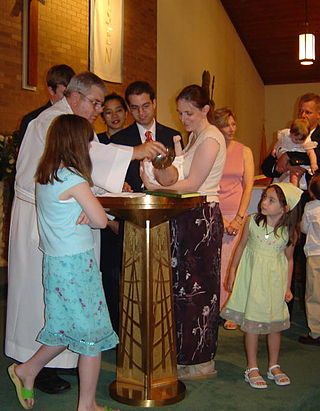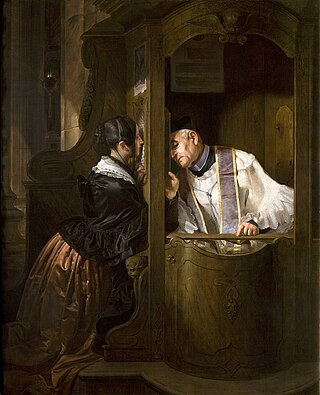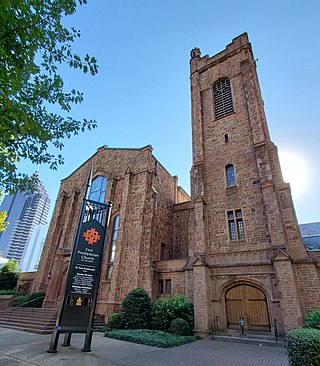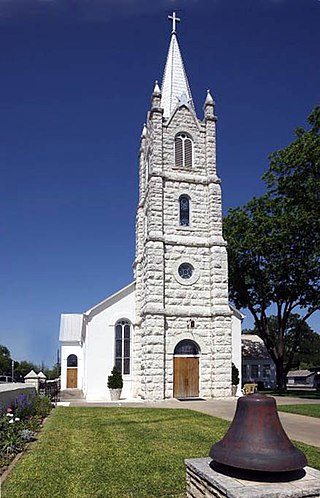
Infant baptism is the practice of baptizing infants or young children. Infant baptism is also called christening by some faith traditions.
Oneness Pentecostalism is a nontrinitarian religious movement within the Protestant Christian family of churches known as Pentecostalism. It derives its name from its teaching on the Godhead, a form of Modalistic Monarchianism commonly referred to as the Oneness doctrine. The doctrine states that there is one God―a singular divine spirit with no distinction of persons―who manifests himself in many ways, including as Father, Son, and Holy Spirit. This stands in sharp contrast to the mainstream doctrine of three distinct, eternal persons posited by Trinitarian theology.

God the Father is a title given to God in Christianity. In mainstream trinitarian Christianity, God the Father is regarded as the first Person of the Trinity, followed by the second person, Jesus Christ the Son, and the third person, God the Holy Spirit. Since the second century, Christian creeds included affirmation of belief in "God the Father ", primarily in his capacity as "Father and creator of the universe".
The Orthodox Presbyterian Church (OPC) is a confessional Presbyterian denomination located primarily in the United States, with additional congregations in Canada, Bermuda, and Puerto Rico. It was founded by conservative members of the Presbyterian Church in the United States of America (PCUSA), who objected to the rise of Liberal and Modernist theology in the 1930s. The OPC is considered to have had an influence on evangelicalism far beyond its size.

Absolution is a theological term for the forgiveness imparted by ordained Christian priests and experienced by Christian penitents. It is a universal feature of the historic churches of Christendom, although the theology and the practice of absolution vary between Christian denominations.

As a general term in theological use, assurance refers to a believer's confidence in God, God's response to prayer, and the hope of eternal salvation. In Protestant Christian doctrine, the term "assurance", also known as the Witness of the Spirit, affirms that the inner witness of the Holy Spirit allows the Christian disciple to know that they are justified. Based on the writings of St. Augustine of Hippo, assurance was historically an important doctrine in Lutheranism and Calvinism, and remains a distinguishing doctrine of Methodism and Quakerism, although there are differences among these Christian traditions. Hymns that celebrate the witness of the Holy Spirit, such as Fanny Crosby's "Blessed Assurance", are sung in Christian liturgies to celebrate the belief in assurance.
The Presbyterian Reformed Church (PRC) is a Presbyterian denomination in Australia. The denomination was formed in 1967, as a result of growing theological liberalism within the Presbyterian Church of Australia, prior to the formation of the Uniting Church in Australia in 1977.

Eucharistic theology is a branch of Christian theology which treats doctrines concerning the Holy Eucharist, also commonly known as the Lord's Supper and Holy Communion.

The Assyrian Evangelical Church is a Presbyterian church in the Middle East that attained a status of ecclesiastical independence from the Presbyterian mission in Iran in 1870.
The Confession of Faith of the Evangelical United Brethren Church is one of five established Doctrinal Standards of the United Methodist Church, along with the Articles of Religion, the General Rules of United Societies, the Standard Sermons of John Wesley, and John Wesley's Explanatory Notes on the New Testament. The United Methodist Church adopted the Confession of Faith in 1968 when the Methodist Church merged with the Evangelical United Brethren Church to form the United Methodist Church. The Confession of Faith covers much of the same ground as the Articles of Religion, but it is shorter and the language is more contemporary. The Confession of Faith also contains an article on the Judgment and Future State which had not been present in the Methodist Articles of Religion.

Thanksgiving after Communion is a spiritual practice among Christians who believe in the Real Presence of Jesus Christ in the Communion bread, maintaining themselves in prayer for some time to thank God and especially listening in their hearts for guidance from their Divine guest. This practice was and is highly recommended by saints, theologians, and Doctors of the Church.

First Presbyterian Church of Atlanta is a congregation of the Presbyterian Church (U.S.A.) located in the Midtown section of Atlanta, Georgia. First Presbyterian Church was founded in 1848, and it was Atlanta's first Presbyterian house of worship. The original church building on Marietta Street was vacated in April 1916 and the property was sold to the U.S. government for the construction of the headquarters of the Federal Reserve Bank of Atlanta. The current church building on Peachtree Street was listed on the National Register of Historic Places in 2020.
Christian theology is the theology – the systematic study of the divine and religion – of Christian belief and practice. It concentrates primarily upon the texts of the Old Testament and of the New Testament, as well as on Christian tradition. Christian theologians use biblical exegesis, rational analysis and argument. Theologians may undertake the study of Christian theology for a variety of reasons, such as in order to:

Zion Lutheran Church is located in Fredericksburg, in Gillespie County, in the U.S. state of Texas. It is the oldest Lutheran Church in the Texas Hill Country and one of the oldest in Texas. The church was built by six families in 1852. On January 13, 1853, twelve founders signed its articles of organization. The cornerstones for the church were set on March 6, 1854. Designated a Recorded Texas Historic Landmark in 1964, Marker number 10132.

The Jarvis Street Baptist Church is a Baptist church located at the intersection of Gerrard Street and Jarvis Street in downtown Toronto. One of the oldest churches in the city, its congregation was founded in 1818, and the present church constructed in 1875. It is a member of the Sovereign Grace Fellowship of Canada.

Grace Presbyterian Church is a Protestant congregation located in Peoria, Illinois. The church's 1,700 members are currently affiliated with the Presbyterian Church in America.
The Brief Statement of Faith is a statement of faith adopted by the Presbyterian Church (USA) in 1991 as part of its Book of Confessions.
The Confession or Declaration of the Pastors which are called Remonstrants, or Remonstrant Confession, was the confession of faith of the Remonstrant brotherhood, published in 1621.












